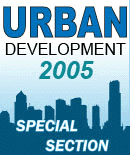
DJC.COM
October 6, 2005
Can Pioneer Square-Stadium District be energy self-sufficient?
International Sustainable Solutions
With daily news about climate change, rising energy costs, and the recent failures within our complex and increasingly vulnerable transmission systems, cities everywhere are beginning to think about how they can have more local control of their energy resources.
|
Lessons from Europe
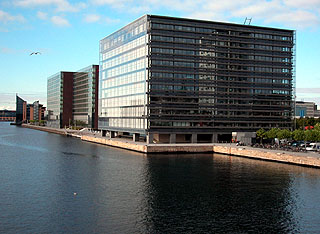
Photo by Steve McConnell/NBBJ
The Nykredit building is located on the waterfront in Copenhagen so cold water can be used to cool offices and then returned to the channel. The system, together with natural ventilation, dramatically reduces the energy needed for cooling.
|
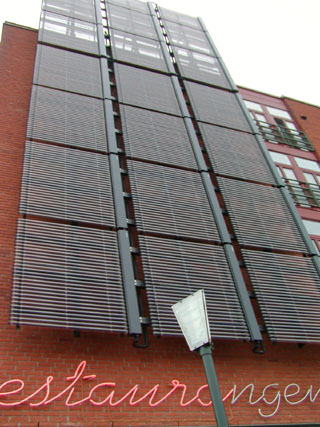
Photo by Hamilton Hazlehurst/Vulcan
Vertically mounted vacuum tube solar collectors in Sweden are more expensive than flat plate collectors, but also have higher efficiencies. The tube shape means the mounting angle is not critical, making them ideal for wall as well as roof top installations.
|
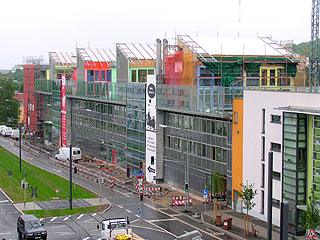
Photo by Jayson Antonoff
The Vauban neighborhood in Freiburg, Germany, is being developed as a model sustainable district on the site of a former military base. Many of the houses produce more energy than they use. Other buildings are heated by a neighborhood-scale combined heat and power station burning wood chips.
|
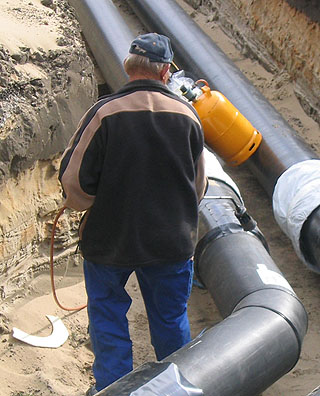
Photo by Jayson Antonoff
Preinsulated piping is used to heat most homes and commercial buildings in Scandinavia. The insulation allows the system to deliver hot water at over 200 degrees to customers up to 15 miles away, with a net temperature drop of only a few degrees.
|
Many are realizing that to insure maximum reliability under any circumstances they will have to intelligently use the energy resources they already have while exploring how to meet more of their demand with locally generated energy.
The U.S. Green Building Council estimates that 36 percent of our energy goes to fulfill the heating, cooling, lighting and other needs of our buildings. Buildings also account for 30 percent of the nation's greenhouse gas emissions.
Washington state and the city of Seattle have made great strides in promoting energy efficient buildings, and LEED rated buildings are now becoming more common. However, some of the greatest opportunities for energy reduction occur outside the envelope of an individual building — where urban planning issues such as siting, access to wind and sun, and public infrastructure investments can have an impact.
The good news is that, in a handful of communities throughout the world, architects, engineers, developers and city planners are combining forces to create neighborhoods with dramatically reduced energy footprints. By drawing on the best practices gleaned from these projects, International Sustainable Solutions, in partnership with the city of Seattle, is now working on a similar initiative here — to develop an action plan for an EnergyPlus Pioneer Square/Stadium District.
This would mean that, on a net annual basis, this neighborhood in a developed, urban environment would produce as much energy as it consumes. It would not be an isolated, self-sufficient island in the city, but would instead integrate with new and existing energy distribution systems, providing excess energy to these systems on some days and consuming power on others. In addition, this strategy could potentially minimize the need for new hydro projects or other large-scale power plants by reducing peak loads.
The neighborhood
The area being studied is a subset of the Sodo neighborhood, roughly extending from Pioneer Square to Holgate, and from the Alaskan Way Viaduct to Interstate 5. The area was selected because it encompasses a broad mix of residential, commercial and other uses, and the stage is now being set for the next 50 years of development, as evidenced by the city's efforts to create a plan for a livable south downtown. In addition, the Reedo Building in the heart of this neighborhood is being renovated by developer Greg Smith and is slated to serve as a nexus for sustainable development in our region.
If we go through this process and then successfully implement the recommendations, Seattle will become recognized as a global leader in sustainability. Not only can we capture the imagination, hopes and dreams of our community, but we will be developing an expertise, and a set of solutions that can be marketed to other communities throughout the world, creating a new economic engine for our region based on sustainable products and services.
Efficient use and production of energy will be one of the largest global market opportunities in the future, and countries such as Denmark, which capitalized on the worldwide growth of the wind energy industry, have already demonstrated the enormous economic potential of this sector.
Project goals
The goal of the project is to demonstrate how an urban area could become energy self-sufficient, with the focus being at the neighborhood scale — fitting the right pieces together to create an affordable and reliable solution.
In order to do this we will be evaluating the overall energy budget of the entire neighborhood and then determining how much of the load can be fulfilled by each of three key strategies:
1. High performance buildings. Using aggressive building efficiency measures such as energy-efficient lighting and appliances, natural ventilation and daylighting to dramatically reduce energy consumption and peak demand.
2. District energy systems. Constructing neighborhood-wide steam or hot water distribution systems, with hydronic heating within buildings. In a mixed-use area like this, with residential, commercial and industrial in close proximity, there are benefits to developing neighborhood-scale central plants. Opportunities could even be tapped for capturing the waste heat generated from some properties, using it to heat and perhaps cool other nearby buildings. This would require a thermal distribution network.
3. Distributed generation, using sustainable energy sources. Developing on-site or neighborhood-scale generation to produce power as close to the loads as possible. This could be based on the renewable sources that typically come to mind such as solar, wind or geothermal energy — or might rely on other locally produced fuels such as municipal solid waste, wood waste and other biofuels.
Beyond the technologies
The most daunting challenges are undoubtedly not in the technologies themselves, but in addressing financial and institutional issues, or simply the resistance to doing something new and unfamiliar.
Energy planning and decision making here is more fragmented than in many parts of the world, making it more difficult to justify the individual investments that could benefit the city or region as a whole. For example, the PSS neighborhood has multiple providers: Seattle City Light for electrical, Puget Sound Energy for gas and Seattle Steam for heat.
Having competing energy suppliers theoretically lowers costs to consumers. However, there is no formal venue to do comprehensive energy planning across institutional lines. Instead, we rely on market forces to determine whether a consumer's heating load can best be met by electricity, gas or steam/hot water — without necessarily having sufficient mechanisms to fund and carry out the best technical solutions.
By comparison, in Malmo, Sweden, E.ON is an integrated energy provider, responsible for meeting all electrical, gas and heating needs of its consumers. It has an inherent incentive to determine how to best meet loads by providing the right combination of these resources, or by investing in conservation. As a result, the decision was made there, as in much of northern Europe, to invest in addition infrastructure and heat most homes and offices with a widespread network of hot water pipes connected to a district energy system.
| How to get involved |
|
Early supporters of this project include the city of Seattle, developer Gregory Broderick Smith, Seattle Steam and the law firm of Mundt MacGregor. If you are interested in being involved, e-mail JaysonA@i-sustain.com.
|
E.ON also installed and owns solar hot water collectors on some of the newer buildings, further expanding its role as a broad-based energy provider.
Innovative financing packages or new types of organizational structures may be needed to support these types of solutions within our own market. The goal of this phase of the initiative is not necessarily to solve all of these problems, but to identify the key barriers to success and define a road map for moving down this path.
If we are successful in this effort, we will find that we have created not only a key initial element in a more reliable and sustainable energy future for Seattle, but also a model that will be studied by other communities throughout the world.
Jayson Antonoff is a sustainable energy expert and co-founder of International Sustainable Solutions.
Other Stories:
- Giving downtown Enumclaw a sense of place
- 5 mega-trends for Puget Sound real estate
- GMA's success depends on local actions
- Finding a home for young urban workers
- Victoria project's goal: 26 LEED platinum buildings
- After Katrina, the chance to build a better city
- Seattle checks into the hotel-condo market
- Everett charts a new waterfront neighborhood
- How to build a town from scratch
Copyright ©2009 Seattle Daily Journal and DJC.COM.
Comments? Questions? Contact us.